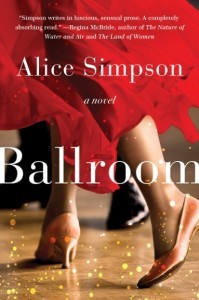Alice Sherman Simpson's Blog: FALL-2023
April 30, 2025
SPEAKING OF BOOKS
Alice Sherman Simpson, author and visual artist will be guest speaker at PEO: Philanthropic Educational Organization, at Mt. San Antonio Gardens in Claremont, CA.
The P.E.O. Sisterhood is a nonprofit organization that has helped more than 125,000* women pursue educational goals by providing more than $435 million in educational assistance, making a difference in women's lives through six philanthropies and a foundation.
Simpson will present her Artist Books About Dance and discuss how her hand-painted books inspire her literary works; BALLROOM (Harper) and THE WINTHROP AGREEMENT (Harper), as well as her recent novel ONE FOR SORROW.
April 26, 2025
GOTTA DANCE
Simpson spoke about the inspiration and connection between her love of dance, the unique hand made artist books she creates about swing, rumba, waltz, Argentine tango—and the novels they have inspired.
ALICE SIMPSON has just completed her third novel. In a series of highly-charged private tango lessons, two strangers; a former solo ballerina and a young Russian ex-pat share a journey that will change their perspective on connection and the human condition.
May 27, 2016
WRITING & OTHER DANCES
MEET THE AUTHOR
ALICE SIMPSON
Wednesday, June 22 at 6:00 pm
Marjorie S. Deane Little Theater
10 West 64th Street
New York, NY
Six lonely souls seek solace on Sunday nights in the faded grandeur of a New York dance hall. It’s 1999, and the ballroom on Union Square has seen better days. Still, in the dim light and dazzling blur of dance after dance—ordinary men and women can escape reality, with all its disappointments to search for their dreams.
An intricate character study, BALLROOM, Simpson’s debut novel,
was published when she was in her mid-seventies, by
Harper Collins, and will appeal to fans of riveting fiction.
Alice Simpson, an accomplished visual artist, taught drawing and design at FIT, the School of Visual Arts, The New School, and Otis-Parsons. She has been widely exhibited and won international acclaim for her sculpture and handcrafted artist books about dance, including Swing!, Dirty Dancing, Rumba, Urban Motion, and Tango Bar. Many of Simpson’s hand-painted books are in the Lincoln Center Library – Jerome Robbins Dance Collection.
- www.alicesimpson.com
November 18, 2015
BALLROOM Party @ EILEEN FISHER
A NIGHT TO REMEBER!
On Thursday evening, October 15th, Eileen Fisher hosted a reading, book signing and champagne celebration of BALLROOM at their Pasadena, California store.
It all began several years ago when I was shopping at a certain legendary department store, and absolutely no one would help me—not in the shoe department—not in the women’s clothing department. I was what we women of a certain age and size call “invisible.” Between my mother before me and my own account we probably had more than 100 years as charge customers. Not one to be silent, I wrote to the corporate offices, and received a “we will look into it” letter.

A few weeks later, passing Eileen Fisher’s store in Pasadena, I asked if I could bring Gypsy, my wire-haired fox terrier into the store. We were welcomed, and treated royally by the staff. A delightful sales-person suggested items that would suit my figure and along with other sales staff, honestly critiqued each, helping me to select several flattering items.
Once again, not one to be silent, I wrote to the Eileen Fisher corporate office to tell them of the wonderful experience I’d had, and mentioned the names of the staff who had been so gracious. Apparently, they passed along my letter back to the staff in Pasadena. Whenever I pass by Eileen Fisher, I pop my head in the door to say “Hi”; they always remember my name.

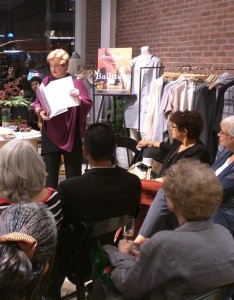
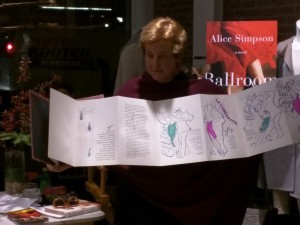
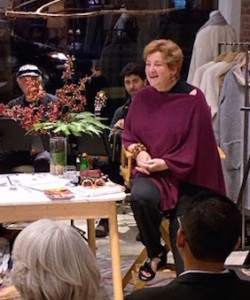
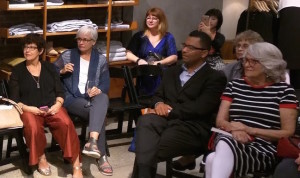
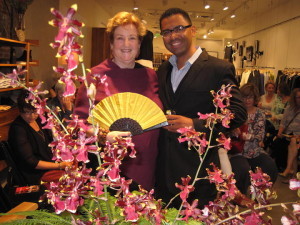
Eileen Fisher knew about the upcoming publication of the paperback edition of BALLROOM, and said that to celebrate they would like to throw a MEET THE AUTHOR party. And did they ever!
Eileen Fisher outfitted me with a stunning new outfit from their new winter collection to be sure I looked my best. There was champagne, hors d’oeuvres, orchids, friends and neighbors, and a tango band.
Accompanied by the Argentinean band Tinto Tango playing the mournful song, Oblivion by Piazzolla, I read a brief and melancholy chapter about Harry and Maria:
“It seems like only moments ago that he waited and watched at the same window. Just like this. Waited and watched for her to come home with Angel from the Copacabana on her sixteenth birthday. It was the best night of my entire life, Harry.” Maria was breathless as she spoke that Friday night, after she came upstairs to his apartment, still wearing what she called her “good” coat. A red ribbon held her dark hair back from her face.
“We won first place, me and Angel—at the Copacabana—and the spotlights were on us, all bright and starry, and such a big dance floor, and oh, Harry, after we won, we got to dance all by ourselves, just me and Angel . . . and everyone applauded for so long . . . and I wished you could have been there to see us win, and see us dancing in the spotlight. God, it was so great. Angel and me? We couldn’t believe Papi let us go! He’s still out, so I wanted to just quickly tell you about tonight. I’m wearing my new outfit so you can see how I look . . . and I can’t believe we won. Angel and me. You’d have been so proud . . . and it was so beautiful! I think it was the very best night of my whole life!”
Her face was flushed, her mahogany eyes dancing with fire. With Angel. Harry felt broken. Like a jigsaw puzzle after you’ve finished it and pulled all the pieces apart. Sitting at his kitchen table, not saying a word, he just stared down at his cracked dance shoes…”
When Harper (Harper Collins) purchased BALLROOM in 2014, I rewarded myself with private tango lessons with Dennis Cante, who came to the party, and surprised me by inviting me to dance a tango. Dennis brought two of his gorgeous professional partners to the party and for everyone’s pleasure danced a tango with Anna Radzikowska Folkerth, followed by a salsa/rumba with Judith Castelan.
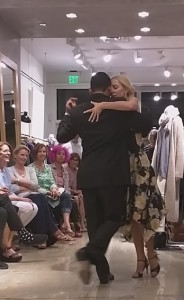
Special thanks to EILEEN FISHER and their marvelous Pasadena staff.
They know how to throw a great party!
Paperback Bestseller – Vroman’s Bookstore
“Simpson is a master at creating realistic characters who are flawed,
a bit unappealing and yet sympathetic.
Life goes on much in the manner in which it began.
But this isn’t a bad thing—it feels real, even refreshing, not to have
a neatly wrapped, feel-good ending—but rather a plain old life-goes-on.
Readers who enjoy seeing inside the hearts and minds of others will relish sharing
the lives of Simpson’s creations.” —writes Kirkus Reviews
Available in bookstores everywhere and online
August 14, 2015
A READER’S GUIDE TO BALLROOM—Questions for Your Book Group Discussion
The Ballroom used to be a place to see and be seen, but the years have taken their toll. By the end of the 1990s, this Manhattan dance hall is a husk of its former self. A small crowd of loyal patrons still makes its way to the worn parquet floor every Sunday evening: although they each have their private reasons for returning again and again to the Ballroom, they all find solace within its walls—and in the magic of dance.
In this deeply felt debut, Alice Simpson deftly unfolds the lives of these men and women, entwining their stories into a profoundly human narrative about our instinctual longing to love and to be loved.
QUESTIONS FOR YOUR BOOK GROUP TO DISCUSS:
1. Ballroom is a novel about dancing—the dancers themselves and their partner relationships— but it is also about the human condition. What are the themes of this book? What does the Ballroom represent?
2. Ballroom can be described as a fugue—a composition in which a short melody or phrase is introduced by one part, successively taken up by others, then developed by interweaving the parts together. How do you think the novel would have been different if only one character was telling the story?
3.The novel is set in New York City in the year 1999. If this book were set in the present day, how do you think the circumstances and relationships portrayed would be different?
4. Sarah yearns for a romance like those she sees on screen. Do you think that cinematic portrayals of love are realistic? Why or why not? How does Sarah’s inability to have a relationship affect her judgment? What might you have done differently than Sarah?
5. Why do you think Gabriel and Myra stay in their marriage?
6. Harry lies to himself. Consider how the other characters rely on self-delusion. What lies do they tell themselves? Do you think most people see themselves clearly?
7. Did you find the characters’ loneliness and inability to form relationships believable? With which character did you most identify? Why?
8. If you could insert yourself as a character in the book, what role would you play? Would you rather be a new character or take the place of an existing one?
9. Have you ever gone dancing or to a nightclub or bar by yourself? Why? What was your impression of the people you met? What was the experience like for you? Would you do it again?
10. Did the end of the book surprise or disappoint you? Did you expect the characters’ lives to be resolved by the end of the book? If you could rewrite the ending, how would you change it?
Ballroom
By Alice Simpson
Harper Paperbacks
ISBN: 9780062323040
LINKS:
Amazon: http://bit.ly/1LurfMJ
Barnes & Noble: http://bit.ly/1DvpGGj
iBooks: http://apple.co/1etEnD7
Books-a-Million: http://bit.ly/1Ijfw0Y
Indiebound: http://bit.ly/1gOGSSt
REVIEW: Library Journal
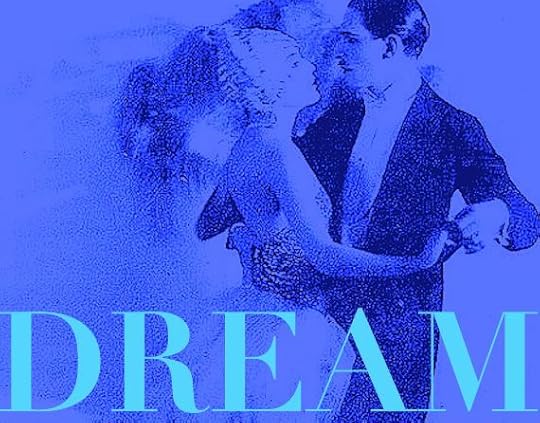
“BALLROOM” – Alice Simpson
Simpson’s first novel narrates the stories of five characters whose passion for ballroom dance and search for true love brings them together every Sunday night. The fictional New York Ballroom-years past its prime (think the recently closed Roseland Ballroom)-mirrors the dancers’ dreams that have, for most, turned drab and stale. The introduction of each figure in short but well-crafted chapters can be tricky at first. The fast-paced interconnected stories require the reader to associate each character with the matching description. Then the narrative begins to flow as fluidly as the accomplished dancers who “seem caught in a whirlwind.” Unmarried Joseph; three-time divorcee Sarah; 65-year-old Harry, in love with Maria, a woman young enough to be his daughter; handsome Angel, who dreams of opening his own dance studio; and lonely Gabriel, mired in a failing marriage-each is consumed by the quest for a fairy-tale ending. But in Sarah’s concluding story, she gives voice to the complexities and disappointments in life. “As if it was like a dance. This step, that step. Quick-quick-slow, just that simple. Always moving clockwise around the floor. But it isn’t like that. Life has no simple steps you can follow.” VERDICT This touching debut captures the intricacies and the unexpected of personal relationships.
—wrote Jane Leder, Evanston, IL, LIBRARY JOURNAL
March 1, 2015
REVIEW: Washington Independent Review of Books
An Interview with Alice Simpson
Susan Storer Clark
February 14, 2015
A visual artist describes how her story leapt out of pictures and onto the page.
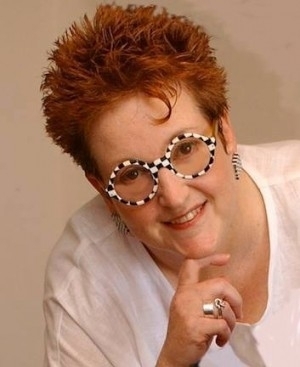
Alice Simpson’s debut novel, Ballroom , braids together the lives of six people, most of them strangers, who frequent a Manhattan ballroom in the 1990s, just before it closes forever. Twice-divorced Sarah is convinced she will finally find true romance; debonair Gabriel is a dazzling dancer but a troubled human being; elderly dance instructor Harry Korn is obsessed with Maria, the daughter of his building superintendent, who dances with her young partner, Angel Morez; and Joseph is yearning for marriage and children. Here, Simpson discusses her cast of characters and the art of writing.
You are an accomplished visual artist, and this novel began as a visual project. How did that happen? And is the cover art yours?
There’s an enchanting place in Maine, guaranteed to change the lives of those who cross the bridge to Deer Isle. It was the early 1990s when I was first accepted at Haystack Mountain School of Crafts. At residencies in this artists’ paradise over the next 13 years, I would explore untouched places of my creativity, making one-of-a-kind, hand-painted books, writing, and then sculpting in clay — finding new directions in my life.
Before attending Haystack, I had kept my creative nose to the grindstone as a designer and illustrator, pleasing clients and corporations. But as graphic design became more and more computerized, I felt less and less connected with the end product.
In a 1994 artist book workshop with the theme of “Place,” I chose the ballroom, which had become so much a part of my life. I had taken up dancing, studying fox trot, waltz, rumba, swing, and the tango. It seemed the perfect motif for my books. I found inspiration in the songs, dances, and people I observed on the dance floor. With a background in fashion illustration, I was able to incorporate paintings of figures — their movement, gesture, and costume.
Part of this hand-painted artist’s book, “Ballroom,” was five funky, two-page stories about some of the dancers. At the Writer’s Voice in New York, in the years that followed, I worked to more fully develop the characters. Those fictional stories grew and grew and soon the characters had apartments, families, yearnings — lives beyond the ballroom on Sunday night. It came as a surprise that, for someone like myself, relentlessly cheerful, the characters were dark and wounded. “Ballroom,” an artist’s book, became Ballroom, a novel.
The elegant and expressive cover art is by Phillip Bannister (UK).
Your father was a fine dancer and a Vaudeville performer. What was he most known for?
My father, Hal Sherman (1897-1985), hung out at amateur houses and dance places as a youngster in South Boston, where black tap dancers taught him to dance. He began entering amateur talent shows at 13, winning contest after contest and soon decided, much to his Orthodox Jewish parents’ chagrin, to leave home and travel the burlesque circuit.
He went on to international renown as a rubber-legged “eccentric” dancer. In the 1920s and 1930s, he danced for royalty, and he and the Duke of Windsor often spent late hours at Maxim’s in Paris, dining and dancing with burlesque showgirls. He was quite the man in three-piece white linen suits, a gold-tipped cane, two Russian Borzois, and his own touring car. He is remembered for his starring Broadway role in “Hell-za-Poppin’” in the 1940s. I only saw him dance once at one of the last stage shows at the Palace Theater on Broadway.
There are several wonderful passages in your book about the transformative power of ballroom dance. One is from Sarah’s point of view: “When a man opens his arms to her and she steps into them, takes his lead, she feels she belongs, she’s important…Even Tony, paunchy and fat, his stupid toupee pasted on his head, makes her feel all of those things: a part of the dance, of something larger than herself.” Were those passages the easiest for you to write, or the hardest?
Admittedly, those passages were the easiest to write, as they express my own feelings when dancing with an experienced partner. In the balance of form and movement — each partner’s complete concentration on the other — there is perfection — being “one.”
While making art and writing, my “self” vanishes. The process is about vision. Dancing the tango, I am fully present, but without vision. Concentrating is different than thinking. Listening, not as an auditory experience, but as a physical experience. I focus on posture, arms, knees, feet, the length of stride, my core, and the frame formed between partners. Holding my own balance — aware of my center — yet submitting. It is a shared and complex experience.
There are two attempts made to take the magic home from the ballroom to the bedroom. Both end in disappointment. Do you think that is inevitable?
Shaped by their histories, it was inevitable that Sarah and Joseph’s attempt to come together would end in failure. They are programmed for disappointment. To Joseph, who has never known love, Sarah is an invention of his imagination. Sarah will inevitably be disillusioned as she searches for movie star romance. Gabriel, emotionally unavailable, sits upon tremendous hostility, to which only the reader is privy.
One sentence in particular made me think, “Wow! She really nailed this guy’s essential character.” It’s from the point of view of Gabriel, a wealthy man who married an artist he met in Greece, someone he has not allowed to practice her art, and she is now a joyless woman and a heavy drinker. “It seemed to Gabriel that she was ruining his life.” Have you known someone who was so completely self-centered who might have expressed such a thought out loud?
I do know people who blame others for their inability to have the lives they want and lack the ability to take responsibility for their own choices. I was challenged by Gabriel and Myra’s relationship; trying to understand why they stayed together — why she allowed him to dominate her. A psychologist told me that some dysfunctional relationships are like the infinity sign — an endless round-and-round dance in which partners know no other steps and therefore remain together.
What are you working on now?
The Waiting List, a psychological thriller about legacy set in New York during two periods — the Gilded Age and the present (periods not so dissimilar). It’s somewhat satirical, with wicked characters you will love to hate. “Flo” Ziegfeld, Diamond Jim Brady, the Dolly Sisters, and gorgeous chorus girls make cameo appearances. It’s about greed, obsession, and murder.
Susan Storer Clark is a former broadcast journalist, who wrote and reported for the Voice of America and WRC-TV in Washington, DC, where she won two Emmys for her work. She loves looking for the “sidebar stories” in history, the lives of ordinary people caught up in extraordinary events, and enjoyed the studies for her degrees in history from Rhodes College and from King’s College London. She is at work on her second novel, about an African woman taken as a prize by Francis Drake on his voyage around the world in 1577-78. She and her husband, Rich, recently moved to the Seattle area, where they are renovating an old farmhouse, and where Susan is learning to play the guitar properly.

REVIEW: Washington Independent Review of Books

Author Q&A
An Interview with Alice Simpson
Susan Storer Clark
February 14, 2015
A visual artist describes how her story leapt out of pictures and onto the page.
Alice Simpson’s debut novel, Ballroom, braids together the lives of six people, most of them strangers, who frequent a Manhattan ballroom in the 1990s, just before it closes forever. Twice-divorced Sarah is convinced she will finally find true romance; debonair Gabriel is a dazzling dancer but a troubled human being; elderly dance instructor Harry Korn is obsessed with Maria, the daughter of his building superintendent, who dances with her young partner, Angel Morez; and Joseph is yearning for marriage and children. Here, Simpson discusses her cast of characters and the art of writing.
You are an accomplished visual artist, and this novel began as a visual project. How did that happen? And is the cover art yours?
There’s an enchanting place in Maine, guaranteed to change the lives of those who cross the bridge to Deer Isle. It was the early 1990s when I was first accepted at Haystack Mountain School of Crafts. At residencies in this artists’ paradise over the next 13 years, I would explore untouched places of my creativity, making one-of-a-kind, hand-painted books, writing, and then sculpting in clay — finding new directions in my life.
Before attending Haystack, I had kept my creative nose to the grindstone as a designer and illustrator, pleasing clients and corporations. But as graphic design became more and more computerized, I felt less and less connected with the end product.
In a 1994 artist book workshop with the theme of “Place,” I chose the ballroom, which had become so much a part of my life. I had taken up dancing, studying fox trot, waltz, rumba, swing, and the tango. It seemed the perfect motif for my books. I found inspiration in the songs, dances, and people I observed on the dance floor. With a background in fashion illustration, I was able to incorporate paintings of figures — their movement, gesture, and costume.
Part of this hand-painted artist’s book, “Ballroom,” was five funky, two-page stories about some of the dancers. At the Writer’s Voice in New York, in the years that followed, I worked to more fully develop the characters. Those fictional stories grew and grew and soon the characters had apartments, families, yearnings — lives beyond the ballroom on Sunday night. It came as a surprise that, for someone like myself, relentlessly cheerful, the characters were dark and wounded. “Ballroom,” an artist’s book, became Ballroom, a novel.
The elegant and expressive cover art is by Phillip Bannister (UK).
Your father was a fine dancer and a Vaudeville performer. What was he most known for?
My father, Hal Sherman (1897-1985), hung out at amateur houses and dance places as a youngster in South Boston, where black tap dancers taught him to dance. He began entering amateur talent shows at 13, winning contest after contest and soon decided, much to his Orthodox Jewish parents’ chagrin, to leave home and travel the burlesque circuit.
He went on to international renown as a rubber-legged “eccentric” dancer. In the 1920s and 1930s, he danced for royalty, and he and the Duke of Windsor often spent late hours at Maxim’s in Paris, dining and dancing with burlesque showgirls. He was quite the man in three-piece white linen suits, a gold-tipped cane, two Russian Borzois, and his own touring car. He is remembered for his starring Broadway role in “Hell-za-Poppin’” in the 1940s. I only saw him dance once at one of the last stage shows at the Palace Theater on Broadway.
There are several wonderful passages in your book about the transformative power of ballroom dance. One is from Sarah’s point of view: “When a man opens his arms to her and she steps into them, takes his lead, she feels she belongs, she’s important…Even Tony, paunchy and fat, his stupid toupee pasted on his head, makes her feel all of those things: a part of the dance, of something larger than herself.” Were those passages the easiest for you to write, or the hardest?
Admittedly, those passages were the easiest to write, as they express my own feelings when dancing with an experienced partner. In the balance of form and movement — each partner’s complete concentration on the other — there is perfection — being “one.”
While making art and writing, my “self” vanishes. The process is about vision. Dancing the tango, I am fully present, but without vision. Concentrating is different than thinking. Listening, not as an auditory experience, but as a physical experience. I focus on posture, arms, knees, feet, the length of stride, my core, and the frame formed between partners. Holding my own balance — aware of my center — yet submitting. It is a shared and complex experience.
There are two attempts made to take the magic home from the ballroom to the bedroom. Both end in disappointment. Do you think that is inevitable?
Shaped by their histories, it was inevitable that Sarah and Joseph’s attempt to come together would end in failure. They are programmed for disappointment. To Joseph, who has never known love, Sarah is an invention of his imagination. Sarah will inevitably be disillusioned as she searches for movie star romance. Gabriel, emotionally unavailable, sits upon tremendous hostility, to which only the reader is privy.
One sentence in particular made me think, “Wow! She really nailed this guy’s essential character.” It’s from the point of view of Gabriel, a wealthy man who married an artist he met in Greece, someone he has not allowed to practice her art, and she is now a joyless woman and a heavy drinker. “It seemed to Gabriel that she was ruining his life.” Have you known someone who was so completely self-centered who might have expressed such a thought out loud?
I do know people who blame others for their inability to have the lives they want and lack the ability to take responsibility for their own choices. I was challenged by Gabriel and Myra’s relationship; trying to understand why they stayed together — why she allowed him to dominate her. A psychologist told me that some dysfunctional relationships are like the infinity sign — an endless round-and-round dance in which partners know no other steps and therefore remain together.
What are you working on now?
The Waiting List, a psychological thriller about legacy set in New York during two periods — the Gilded Age and the present (periods not so dissimilar). It’s somewhat satirical, with wicked characters you will love to hate. “Flo” Ziegfeld, Diamond Jim Brady, the Dolly Sisters, and gorgeous chorus girls make cameo appearances. It’s about greed, obsession, and murder.
Susan Storer Clark is a former broadcast journalist, who wrote and reported for the Voice of America and WRC-TV in Washington, DC, where she won two Emmys for her work. She loves looking for the “sidebar stories” in history, the lives of ordinary people caught up in extraordinary events, and enjoyed the studies for her degrees in history from Rhodes College and from King’s College London. She is at work on her second novel, about an African woman taken as a prize by Francis Drake on his voyage around the world in 1577-78. She and her husband, Rich, recently moved to the Seattle area, where they are renovating an old farmhouse, and where Susan is learning to play the guitar properly.

November 6, 2014
REVIEW: A minuet of love and misery

By Christina Varrasso
If you’re interested in reading a novel filled with likable characters whose intertwining relationships will wrap neatly into a perfect happy ending, BALLROOM …is not for you.
However, if you are open to experiencing a beautifully written novel whose six characters’ piquant voices will invite you to a ballroom to share their passion for dancing and experience their deep seeded dreams and often unfulfilled desires, then put on your dancing shoes and get ready for a great story.
Alice Simpson is an accomplished video artist who taught drawing and design at Fashion Institute of Technology, the School of Visual Arts, the New School and Otis Parsons. She has won international acclaim for a series of handcrafted artist books about dance. She is a sculptor, painter, ballroom dancer, and writer.
In “Ballroom,” her debut novel, Ms. Simpson marries her love of art forms with her passion for dancing to create a story filled with complicated (sometimes unlikeable) characters and spectacular imagery that makes any novelist’s mouth water. Every Sunday night, Ms. Simpson’s six lost characters come together at the Ballroom, a once grand dance club in late 1990s New York City, to dance intimate tangos, salsa and waltzes. They know each other superficially, and it is only through hearing their interconnected stories in alternating chapters do we learn about their troubled lives and hidden desires as their paths cross both on and off the dance floor.
Harry Korn, age 65, lives on his pension and the money he earns giving private dance lessons to women he meets at the Ballroom. He is saving money to take the woman of his dreams, Maria Rodriguez, to Buenos Aires. He looks forward to his weekly dance lesson with her in his top-floor apartment.
When Harry shares a long held secret with her, the outcome is heart wrenching. Maria, a soon-to-be graduate from Barnard, struggles to keep her clandestine dance lessons with Harry from her father and from her dance partner and secret love, Angel Morez. Angel, despite his father’s plans for him, has a huge dream of opening a state-of-the-art dance studio with Maria as his future wife.
But he must answer a nagging question first: where does she insist on going alone every Friday night? Dry Joseph, whose last name he never divulges, is a bachelor and believes marriage to red-haired beauty Sarah Dreyfus will bring him happiness. But Sarah insecure and thrice divorced, wants ladies’ man Gabriel Katz to be husband number four.
But Gabriel is already married and attends the Ballroom to escape his own failing marriage to an alcoholic. But even on the dance floor he chases the ghost of his first dance partner: his deceased, manipulative, and obsessively doting mother.
Through the dances they share, the characters experience sexual tension but most never develop any true emotional intimacy. The Ballroom is a place where they chase hopes and dreams that are rarely fulfilled. We almost get the feeling that although they know what they want, they are too afraid to take the next step, if you will, to make their dreams a reality.
Ms. Simpson is brilliant at creating realistic characters that are flawed and have an effect on the reader. When the novel ends without any true unified ending, we are initially left feeling that the author missed something, that there should have been more, that some characters were left dangling in fictional abyss.
But I think the author intended this. Life does not wrap up neatly for anyone. We dance through life day by day with hopes and aspirations of our own, some fulfilled, some not. We encounter and cross paths with people whom we never see or think about again. I once read that literature is supposed to speak to us, force us to question humanity and existentialism, to affect us. Alice Simpson accomplished this with “Ballroom.” —writes Christina Varrasso, author of “Running for Yellow.” She lives in Hampton.
http://www.post-gazette.com/ae/books/...

FALL-2023
- Alice Sherman Simpson's profile
- 76 followers


